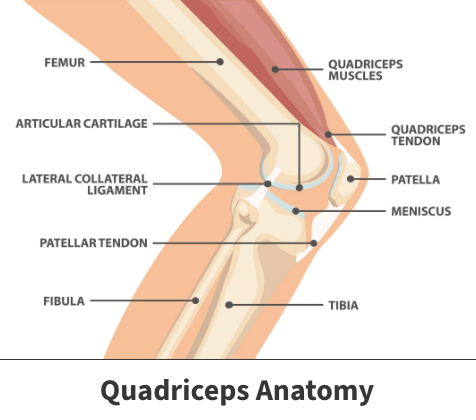Quadriceps tendon tear
A quadriceps tendon tear is an injury that occurs when the tendon in the front of your thigh tears partially or entirely. This injury is most commonly due to an abrupt, forcefully impact on your thigh. There are both surgical and nonsurgical treatment options available to help heal your quadriceps tendon. Your Florida Orthopaedic Institute physician will walk you through your options and help determine how to best treat your injury.
Quadriceps tendon tears are rare but serious injuries. While not common, they most often occur among middle-aged people who play running or jumping sports.
Anatomy

Tendons are strong cords of fibrous tissue that attach muscles to bones. The quadriceps tendon attaches the four quadriceps muscles that meet just above the kneecap (patella). The patella is attached to the shinbone (tibia) by a tendon known as the patellar tendon. All these muscles and tendons work together in the front of your thigh to straighten the knee.
About
A quadriceps tendon tear is an injury that results in the tendon in the front of your thigh to rip. There are two different types of tears; partial tears, and complete tears. In a partial tear, the tendon is not fully torn. A partial tear is like a rope that is stretched so far that some of the fibers fray, but the rope does not break. A complete tear, as the name suggests, occurs when the quadriceps tendon entirely tears.
A quadriceps tendon tear often occurs when there is a heavy load on the leg with the foot planted and the knee partially bent. This type of tear is also caused by falls, direct force to the front of the knee, or a deep cut.
Several factors can increase your chance of tearing your quadriceps tendon, such as:
- Chronic renal failure
- Conditions associated with renal dialysis
- Hyperparathyroidism
- Gout
- Leukemia
- Rheumatoid arthritis
- Systemic Lupus Erythematosus (SLE)
- Diabetes Mellitus
- Infection
- Metabolic Disease
- Steroid use
- Prolonged immobilization
- Fluoroquinolones (a specific type of antibiotic)

Symptoms
When the quadriceps tendon tears, there is often an initial tearing or popping sensation, followed by pain and swelling. You may also experience some or all the following symptoms:
- Tenderness
- Inability to straighten the knee
- Bruising
- Cramping
- An indentation at the top of your kneecap where the tendon tore
- Saggy or droopy kneecap
- Difficulty walking due to the knee-buckling or giving away
Diagnosis
Your Florida Orthopaedic Institute physician will analyze your symptoms, medical history, and general health, followed by a thorough examination of your knee. To determine the exact cause of your symptoms, your doctor will test how well you can extend or straighten your knee.
To confirm your diagnosis, your physician may order some imaging test, such as:
- X-rays – The kneecap moves out of place when the quadriceps tendon tears. The tear is often very obvious on a lateral X-ray view of the knee. Complete tears are usually identified with these X-rays alone.
- Magnetic resonance imaging (MRI) – This scan creates better images of soft tissues like the quadriceps tendon. The MRI can show the amount of tendon that is torn and the location of the tear. Sometimes, an MRI is needed to rule out a different injury with similar symptoms.
Treatment
There are both surgical and non-surgical treatments available to help get you healed as quickly as possible. Typically, if the quadriceps tendon is not fully torn, then non-surgical treatments are an excellent treatment option. But if the tendon is fully torn, then surgery will most likely be necessary.
Nonsurgical treatments
Most small, partial tears can heal with nonsurgical treatments. The nonsurgical treatments that work best for quadriceps tendon tears are:
- Immobilization – Keeping the tendon as still as possible will help allow it to heal. Immobilization can be done with a knee immobilizer or a brace. You will most likely need crutches to help you avoid putting all your weight on your leg. You can expect to be in a knee immobilizer or brace for three to six weeks.
- Physical therapy – Once the initial pain and swelling have settled, physical therapy can begin. The purpose of physical therapy for a quadriceps tendon tear is to regain strength and range of motion. Your physician will help determine what physical therapy routine will help you heal the best.
Learn More About Physical Therapy
Surgical treatments
Most people who completely tear their triceps tendon will need surgery to repair it. Surgical repair reattaches the torn tendon to the top of the kneecap. To reattach the tendon, sutures are placed in the tendon and then threaded through drill holes in the kneecap. The sutures tie to the bottom of the kneecap. Your surgeon will carefully tie the sutures to get the right tension in the tendon. This also makes sure the position of the kneecap closely matches that of your uninjured kneecap.
People who need surgery do better if the repair is performed as soon as possible after their injury. Early repair may prevent the tendon from scarring and tightening into a shortened position.
Videos
Related specialties
- ACL Injuries
- Arthroscopic Chondroplasty
- Articular Cartilage Restoration
- Deep Thigh Bruising
- Fractures of the Tibial Spine
- Iliotibial Band Syndrome
- Lateral Collateral Ligament (LCL) Injuries
- MACI
- Medial Collateral Ligament Injuries
- Meniscus Tears
- Muscle Spasms
- Muscle Strains of the Calf
- Partial Knee Replacement
- Patellar Fracture
- Runner's Knee
- Senior Strong
- Shin Splints
- Total Knee Replacement Surgery
